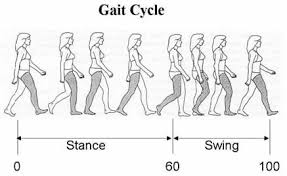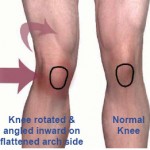Can fallen Arches cause Knee Pain?….in short, Yes, fallen arches can cause knee pain, along with hip, pelvis and low back pain. To understand how this occurs we first need to look at how we walk or the gait cycle.
During the gait cycle our legs pass through the “stance phase”, this is where our foot strikes the ground and stabilises the stance foot, leg and hip to allow the other leg pass through the “swing phase” and so on.

During the stance phase the foot plants itself on the ground creating a stable surface, this is done by using the small intrinsic muscles of the foot, lower leg muscles and other elements of the ankle, foot and hip.
One of the dysfunctions that can effect the stability of the foot is Fallen Arches or a weakness in the small intrinsic muscles of the foot thus allowing the foot to over- pronate during the gait cycle .
 When the arch of your foot weakens and collapses (over-pronates) as the foot strikes the ground the lower part of your leg (tibia or shin bone) rotates inwards. As the lower limb rotates inwards this puts additional pressure on the knee structure, thus causing misalignment of the knee during the gait cycle. If you multiple this movement pattern by a few thousands steps a day or load the knee further by running on this pattern…yes you will have knee pain…sooner or later. As mentioned, in addition to knee pain, the hip, pelvis and lower back can also be affected by fallen arches causing pain in these areas.
When the arch of your foot weakens and collapses (over-pronates) as the foot strikes the ground the lower part of your leg (tibia or shin bone) rotates inwards. As the lower limb rotates inwards this puts additional pressure on the knee structure, thus causing misalignment of the knee during the gait cycle. If you multiple this movement pattern by a few thousands steps a day or load the knee further by running on this pattern…yes you will have knee pain…sooner or later. As mentioned, in addition to knee pain, the hip, pelvis and lower back can also be affected by fallen arches causing pain in these areas.
As a Physical Therapist there are a couple of options I make available to clients to help resolve this issue. One factor to consider with Fallen Arches is that they can be heredity and as result of this an exercise program may not be as effective on the weakned muscles. For these clients I stock a custom designed off the shelf Orthotic to help support the arches and correct their movement pattern, the Orthotic is to be used in conjunction with foot strengthening exercises.
For other clients I will always look to work with them to strengthen their intrinsic foot muscles to ensure they can create the stability need to prevent over-pronation. This is done through a series of soft tissue and foot mobilisations techniques, which are support by foot straightening exercises, such as picking up a pen with your toes.
I also explain the tripod position of the foot to ensure clients understand what biomechanics are taking place and how they can help themselves to correct over-pronantion on a more permanent basis without the use of expensive ortothics.
Tripod Ex:
If you have foot, knee, hip or low back pain or fallen arches please contact Range of Motion Physical Therapy for an appointment.

